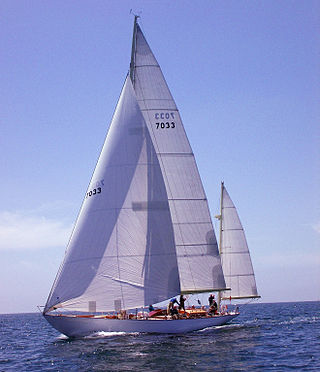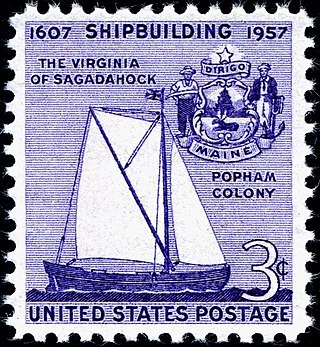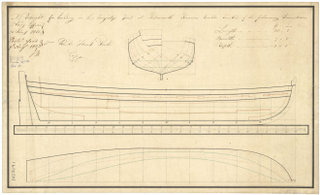
The full-rigged pinnace was the larger of two types of vessel called a pinnace in use from the sixteenth century.

The full-rigged pinnace was the larger of two types of vessel called a pinnace in use from the sixteenth century.
The word pinnace, and similar words in many languages (as far afield as Indonesia, where the boat "pinisi" took its name from the Dutch pinas [1] ), came ultimately from the Spanish pinaza c. 1240, from pino (pine tree), from the wood of which the ships were constructed. The word came into English from the Middle French pinasse. [2]
"The pinnace is perhaps the most confusing of all the early seventeenth-century types of vessels. Pinnace was more of a use than a type name, for almost any vessel could have been a pinnace or tender to a larger one. Generally speaking, pinnaces were lightly built, single-decked, square-sterned vessels suitable for exploring, trading, and light naval duties. On equal lengths, pinnaces tended to be narrower than other types. Although primarily sailing vessels, many pinnaces carried sweeps for moving in calms or around harbors." [3]
The rigs of pinnaces included the single-masted fore-and-aft rig with staysail and sprit mainsail to the mizzenmast, and a square sprit-sail under the bowsprit. Open square-sterned pulling boats were also called pinnaces at least as early as 1626. The larger pinnace 'type' was often much larger than the smaller tender type, and frequently carried enough cannon to be considered an (armed) merchantman, or fast and maneuverable small warship.
The English pinnace Sunne was the first vessel reported built at the Chatham Dockyard, in 1586. [4] English pinnaces of the time were typically of around 100 tons, and carried 5 to 16 guns. [5]
The Dutch built pinnaces during the early 17th century.[ citation needed ] Dutch pinnaces had a hull form resembling a small race-built galleon and usually rigged as a ship (square rigged on three masts), or carrying a similar rig on two masts (in a fashion akin to the later "brig"). Pinnaces were used as fast merchant vessels, pirate vessels and small warships. Not all were small vessels, some being nearer to larger ships in tonnage.[ citation needed ]
This type saw widespread use in northern waters, as they had a shallow draught. In 2009 the wreck of an Elizabethan English pinnace with a set of twelve matched cannon was discovered, the first of its type for the time. Vessels at that time typically carried a mixture of unmatched cannon using disparate ammunition. The matched armament is considered revolutionary, and a contributing factor to the deadly reputation of the English naval artillery. [6]
The first English ship built in North America, Virginia of Sagadahoc, was a pinnace.

A schooner is a type of sailing vessel defined by its rig: fore-and-aft rigged on all of two or more masts and, in the case of a two-masted schooner, the foremast generally being shorter than the mainmast. A common variant, the topsail schooner also has a square topsail on the foremast, to which may be added a topgallant. Differing definitions leave uncertain whether the addition of a fore course would make such a vessel a brigantine. Many schooners are gaff-rigged, but other examples include Bermuda rig and the staysail schooner.

A sailing vessel's rig is its arrangement of masts, sails and rigging. Examples include a schooner rig, cutter rig, junk rig, etc. A rig may be broadly categorized as "fore-and-aft", "square", or a combination of both. Within the fore-and-aft category there is a variety of triangular and quadrilateral sail shapes. Spars or battens may be used to help shape a given kind of sail. Each rig may be described with a sail plan—formally, a drawing of a vessel, viewed from the side.

A yawl is a type of boat. The term has several meanings. It can apply to the rig, to the hull type or to the use which the vessel is put.

A barque, barc, or bark is a type of sailing vessel with three or more masts and fore mast, mainmast and additional masts rigged square and only the aftmost mast rigged fore and aft. Sometimes, the mizzen is only partly fore-and-aft rigged, bearing a square-rigged sail above.

Galleons were large, multi-decked sailing ships developed in Portugal and Spain and first used as armed cargo carriers by Europeans from the 16th to 18th centuries during the age of sail and were the principal vessels drafted for use as warships until the Anglo-Dutch Wars of the mid-1600s. Galleons generally carried three or more masts with a lateen fore-and-aft rig on the rear masts, were carvel built with a prominent squared off raised stern, and used square-rigged sail plans on their fore-mast and main-masts.

A longboat is a type of ship's boat that was in use from circa 1500 or before. Though the Royal Navy replaced longboats with launches from 1780, examples can be found in merchant ships after that date. The longboat was usually the largest boat carried. In the early period of use, a ship's longboat was often so large that it could not be carried on board, and was instead towed. For instance, a survey of 1618 of Royal Navy ship's boats listed a 52 ft 4 in (16 m) longboat used by the First Rate Prince, a ship whose length of keel was 115 ft (35 m). This could lead to the longboat being lost in adverse weather. By the middle of the 17th century it became increasingly more common to carry the longboat on board, though not universally. In 1697 some British ships in chase of a French squadron cut adrift the longboats they were towing in an attempt to increase their speed and engage with the enemy.

A cutter is a name for various types of watercraft. It can apply to the rig of a sailing vessel, to a governmental enforcement agency vessel, to a type of ship's boat which can be used under sail or oars, or, historically, to a type of fast-sailing vessel introduced in the 18th century, some of which were used as small warships.

The mast of a sailing vessel is a tall spar, or arrangement of spars, erected more or less vertically on the centre-line of a ship or boat. Its purposes include carrying sails, spars, and derricks, giving necessary height to a navigation light, look-out position, signal yard, control position, radio aerial or signal lamp. Large ships have several masts, with the size and configuration depending on the style of ship. Nearly all sailing masts are guyed.
This glossary of nautical terms is an alphabetical listing of terms and expressions connected with ships, shipping, seamanship and navigation on water. Some remain current, while many date from the 17th to 19th centuries. The word nautical derives from the Latin nauticus, from Greek nautikos, from nautēs: "sailor", from naus: "ship".

Launch is a name given to several different types of boat. The wide-range of usage of the name extends from utilitarian craft through to pleasure boats built to a very high standard.

A Thames sailing barge is a type of commercial sailing boat once common on the River Thames in London. The flat-bottomed barges, with a shallow draught and leeboards, were perfectly adapted to the Thames Estuary, with its shallow waters and narrow tributary rivers. The larger barges were seaworthy vessels, and were the largest sailing vessel to be handled by just two men. The average size was about 120 tons and they carried 4,200 square feet (390 m2) of canvas sail in six working sails. The mainsail was loose-footed and set up with a sprit, and was brailed to the mast when not needed. It is sheeted to a horse, as is the foresail; they require no attention when tacking. The foresail is often held back by the mate to help the vessel come about more swiftly.

The Cruizer class was an 18-gun class of brig-sloops of the Royal Navy. Brig-sloops were the same as ship-sloops except for their rigging. A ship-sloop was rigged with three masts whereas a brig-sloop was rigged as a brig with only a fore mast and a main mast.

Literally, the word pinisi refers to a type of rigging of Indonesian sailing vessels. A pinisi carries seven to eight sails on two masts, arranged like a gaff-ketch with what is called 'standing gaffs' — i.e., unlike most Western ships using such a rig, the two main sails are not opened by raising the spars they are attached to, but the sails are 'pulled out' like curtains along the gaffs which are fixed at around the centre of the masts.

Virginia or Virginia of Sagadahoc was a pinnace built in 1607 and 1608 by English colonists at the Popham Colony. The ship was a project of the Plymouth Company, branch of the proprietary Virginia Company, on land England claimed as belonging to the Virginia Colony. She was the first English ocean-going vessel built in the New World, and a demonstration of the new colony's ability to build ships. The second and third "local" pinnaces were built soon afterwards in Bermuda following the loss of Sea Venture during the Third Supply.

The Sparrow-Hawk was a 'small pinnace' similar to the full-rigged pinnace Virginia that sailed for the English Colonies in June 1626. She is the earliest ship to participate in the first decades of English settlement in the New World to have survived to the present day.

As a ship's boat, the pinnace is a light boat, propelled by oars or sails, carried aboard merchant and war vessels in the Age of Sail to serve as a tender. The pinnace was usually rowed but could be rigged with a sail for use in favorable winds. A pinnace would ferry passengers and mail, communicate between vessels, scout to sound anchorages, convey water and provisions, or carry armed sailors for boarding expeditions. The Spanish favored them as lightweight smuggling vessels while the Dutch used them as raiders. In modern parlance, "pinnace" has come to mean an auxiliary vessel that does not fit under the "launch" or "lifeboat" definitions.

A ship's boat is a utility boat carried by a larger vessel. Ship's boats have always provided transport between the shore and other ships. Other work done by such boats has varied over time, as technology has changed. In the age of sail, especially for warships, an important role was the collection of drinking water. The use of radio, followed by telex, e-mail, etc. has reduced and then replaced the need for written communications to be delivered. A large enough boat may be needed to carry an anchor to some distance away from the ship, so as to kedge out of a harbour or away from a hazard – and also to recover such an anchor afterwards. Warships have always used their boats as an extension to their military role. This includes the provision of a means of escape for the crews of fireships, the landing of troops, or the "cutting out" raids that were used by the Royal Navy, especially during the Napoleonic Wars. All these requirements competed with the need to be able to stow the boats on board in a way that did not interfere with the normal operation of the ship.
This glossary of nautical terms is an alphabetical listing of terms and expressions connected with ships, shipping, seamanship and navigation on water. Some remain current, while many date from the 17th to 19th centuries. The word nautical derives from the Latin nauticus, from Greek nautikos, from nautēs: "sailor", from naus: "ship".
This glossary defines the various types of ships and accessory watercraft that have been used in service of the United States. Such service is mainly defined as military vessels used in the United States Navy and United States Coast Guard, as well as the defunct, incorporated, or renamed institutions such as the United States Revenue Cutter Service. Service of the United States can also be defined in this context as special government missions in the form of expeditions, such as the Wilkes Expedition or the North Pacific Exploring and Surveying Expedition. The scope of the glossary encompasses both the "Old Navy" of the United States, from its beginnings as the "Continental Navy", through the "New Navy" and up to modern day. The watercraft included in the glossary are derived from United States ships with logbooks published by the National Archives and Records Administration.